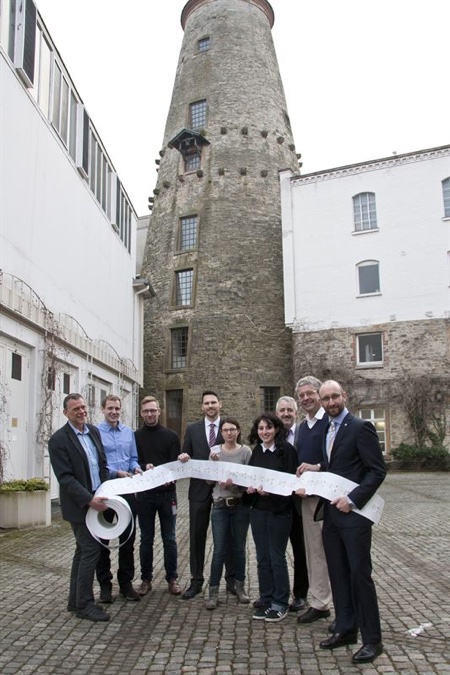Specialty Paper For Printing Smart Labels
Press release from the issuing company
Research ministry invites the Felix Schoeller Group to Hannover Messe
Osnabrück - From idea to application, from printed batteries to complex systems; there has been significant progress in research and development in the field of printed electronics. The Felix Schoeller Group has contributed to this by developing high-gloss papers with good dimensional stability as a substrate for printed electronics. And its efforts have borne fruit: at this year’s LOPEC, the International Exhibition and Conference for Printed Electronics in Munich, the EU-funded research project A3ple received a best demonstrator award in the projects funded by the public sector category. German research minister Prof. Johanna Wanka also invited the BatMat project to take part in the Hannover Messe from 13 to 17 April. At the joint stand hosted by the Federal Ministry for Education and Research at this trade show, the Felix Schoeller Group is one of eight project partners to showcase printed nickel metal hydride batteries - both primary and rechargeable.
“Printed electronics is an interesting area that offers new applications for paper. We are learning to further optimise our specialty papers in projects such as BatMat and A3ple,” Dr Wolfgang Schmidt explains. As head of research and development in this field and spokesperson for the consortium, he has coordinated the BatMat-Team since 2011. During that time, the Felix Schoeller Group has developed special paper grades that it has called p_e:smart. Their extremely smooth finish means that they can be used as an alternative substrate for printed electronics in applications where films would otherwise be used. In this way, the company has paved the way for further exciting applications in the field of printed electronics. They include, for example, packaging that incorporates printed electrodes and luminescent materials that produce flashing lettering or touch-sensitive switches printed onto furniture fronts.
“The decisive advantage of our specialty papers is their dimensional stability even at higher temperatures. That is particularly important when several conductive layers are successively applied to a substrate, each one of which has to be individually heat dried,” Dr Schmidt explains. “Any change to the surface of the substrate this might cause could compromise the 100% accuracy of fit that is absolutely essential for printed circuits to work properly, for example.”
Whereas the BatMat project focused on a single aspect – printed batteries – the EU project A3ple was dedicated to complex systems. As one of two project partners from Germany, the Felix Schoeller Group is once again responsible for developing the paper substrate. Particular attention here has been paid to new printing techniques and materials and to issues of environmental soundness and sustainability.
The international team - consisting of representatives from Finland, Portugal, Italy, France and the Netherlands - succeeded in printing smart labels that can measure temperature or the concentration of gases. Specific applications for these portable sensors include stickers for protective clothing for firefighters and paramedics to use in rescue work in burning buildings. Labels that monitor temperature compliance along the cooling chain for highly sensitive medication are also a possibility. The labels consist of a sensor, analysis logics in the form of a simple circuit, a display and a power supply. Everything is applied in consecutive steps to the specialty paper using carbon, silver and conductive polymers, as well as zinc and manganese dioxide for the integrated battery. In future it will also be possible to directly print onto storage media. The labels are simple to make and can be disposed of without putting any additional strain on the environment.

Picture: Printed batteries off the roll presented by the BatMat team in Osnabrück. On behalf of the Felix Schoeller Group, Dr Wolfgang Schmidt (left) welcomed the project partners Patrick Rassek (HdM - Stuttgart Media University ), Michael Wendler (VARTA Microbattery Ellwangen), Markus Alferi (VDI Technologiezentrum Düsseldorf), Katja Tekbas (Schoeller Technocell), Monique Helmert (TU Chemnitz), Prof. Dr Hübner (HdM), Dr Martin Krebs (VARTA) and Dr Stefan Pieper (VDI) (from left to right).
- Questions to ask about inkjet for corrugated packaging
- Can Chinese OEMs challenge Western manufacturers?
- The #1 Question When Selling Inkjet
- Integrator perspective on Konica Minolta printheads
- Surfing the Waves of Inkjet
- Kyocera Nixka talks inkjet integration trends
- B2B Customer Tours
- Keeping Inkjet Tickled Pink
© 2024 WhatTheyThink. All Rights Reserved.














